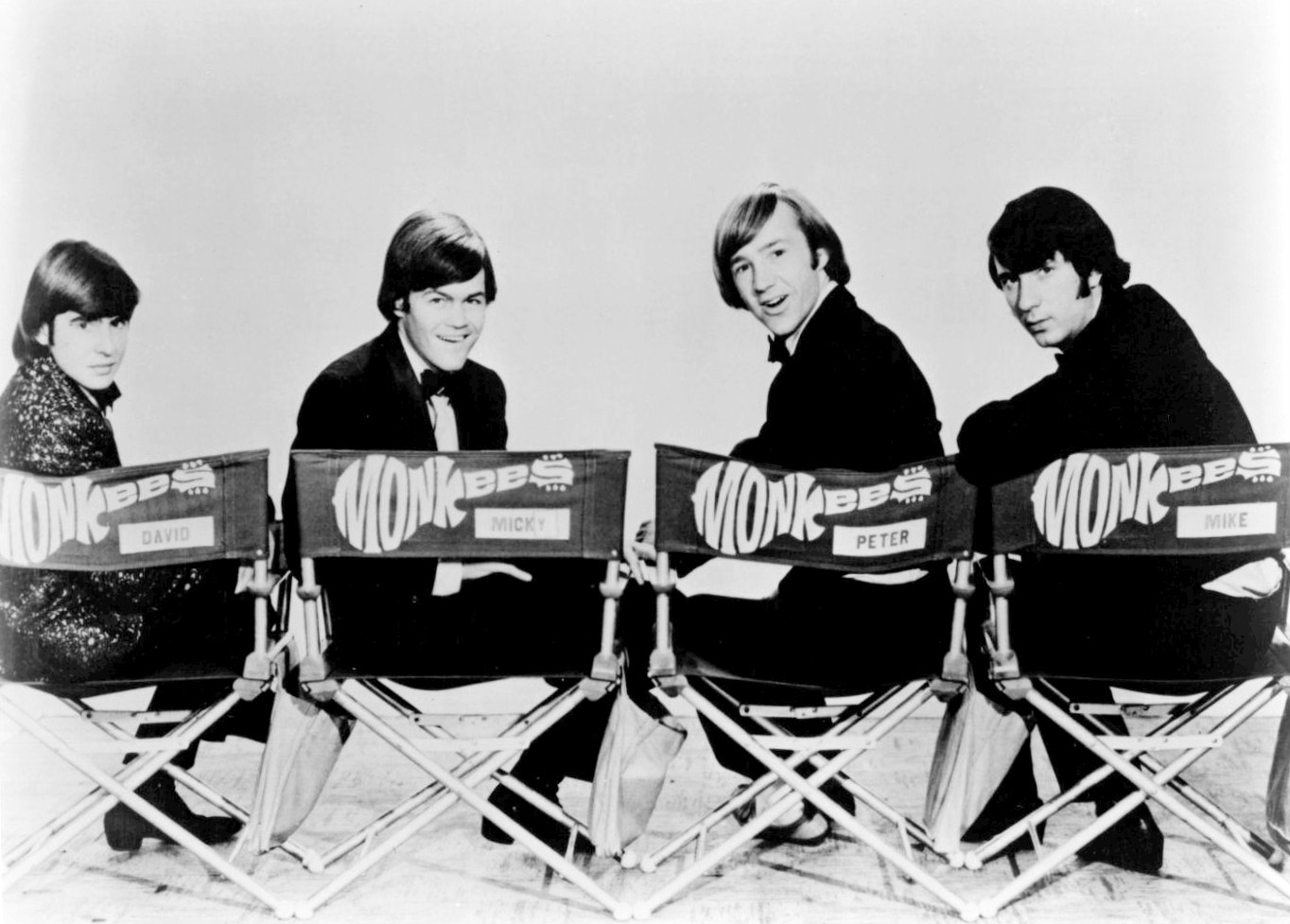|
I'll Be Back Up On My Feet
"I'll Be Back Up on My Feet" is a song by Sandy Linzer and Denny Randell, which was recorded by The Monkees during the 1960s. The first Monkees version of the song was recorded on October 26, 1966, during the period when the band did not have control over their recordings. This version was produced by Jeff Barry, and was used in two first-season episodes of their series, "Dance, Monkees, Dance", episode 14 and "Monkees In the Ring", episode 20. (In the former, the show's credits mistakenly listed the title as "I'll Be Back On My Feet Again"). The recording was slated to be included on ''More of the Monkees'', but was pulled from the album's lineup, and never originally released. During 1967 and 1968, the Monkees remade several of their earlier songs, including "Valleri" and selections that appeared on their ''Headquarters'' album, after the band gained control over the production of their records. During sessions for their '' Pisces, Aquarius, Capricorn & Jones Ltd.'' album, the M ... [...More Info...] [...Related Items...] OR: [Wikipedia] [Google] [Baidu] |
The Monkees
The Monkees were an American rock and pop band, formed in Los Angeles in 1966, whose lineup consisted of the American actor/musicians Micky Dolenz, Michael Nesmith and Peter Tork alongside English actor/singer Davy Jones. The group was conceived in 1965 by television producers Bob Rafelson and Bert Schneider for the situation comedy series of the same name. Music credited to the band was released on LP, as well as being included in the show, which aired from 1966 to 1968. While the sitcom was a mostly straightforward affair, the music production generated tension and controversy almost from the beginning. Music supervisor Don Kirshner was dissatisfied with the quartet's musical abilities, and he limited their involvement during the recording process, relying instead on professional songwriters and studio musicians. This arrangement yielded multiple hit albums and singles, but it did not sit well with the band members, who were facing a public backlash for not playing on the ... [...More Info...] [...Related Items...] OR: [Wikipedia] [Google] [Baidu] |
Pisces, Aquarius, Capricorn & Jones Ltd
''Pisces, Aquarius, Capricorn & Jones Ltd.'' is the fourth album by the Monkees. It was released on November 6, 1967, when the Monkees were exerting more control over their music and had started to play many of the instruments themselves, something that their record company had previously forbidden. However, though the group had full control over the album, they invited more contributions from outside songwriters than on their previous album, ''Headquarters'', and used session musicians to complement their sound. The album also featured some of the earliest uses of the Moog synthesizer in popular music. ''Pisces, Aquarius, Capricorn & Jones Ltd.'' sold more than three million copies and was also the band's fourth consecutive album to reach number one on the U.S. ''Billboard'' 200. History The group employed studio musicians to a greater extent than their previous album, ''Headquarters'', on which the four musicians played almost entirely on their own. Part of the reason for the ... [...More Info...] [...Related Items...] OR: [Wikipedia] [Google] [Baidu] |
The Monkees Songs
''The'' () is a grammatical article in English, denoting persons or things already mentioned, under discussion, implied or otherwise presumed familiar to listeners, readers, or speakers. It is the definite article in English. ''The'' is the most frequently used word in the English language; studies and analyses of texts have found it to account for seven percent of all printed English-language words. It is derived from gendered articles in Old English which combined in Middle English and now has a single form used with pronouns of any gender. The word can be used with both singular and plural nouns, and with a noun that starts with any letter. This is different from many other languages, which have different forms of the definite article for different genders or numbers. Pronunciation In most dialects, "the" is pronounced as (with the voiced dental fricative followed by a schwa) when followed by a consonant sound, and as (homophone of pronoun ''thee'') when followed by a v ... [...More Info...] [...Related Items...] OR: [Wikipedia] [Google] [Baidu] |
1966 Songs
Events January * January 1 – In a coup, Colonel Jean-Bédel Bokassa takes over as military ruler of the Central African Republic, ousting President David Dacko. * January 3 – 1966 Upper Voltan coup d'état: President Maurice Yaméogo is deposed by a military coup in the Republic of Upper Volta (modern-day Burkina Faso). * January 10 ** Pakistani–Indian peace negotiations end successfully with the signing of the Tashkent Declaration, a day before the sudden death of Indian prime minister Lal Bahadur Shastri. ** The House of Representatives of the US state of Georgia refuses to allow African-American representative Julian Bond to take his seat, because of his anti-war stance. ** A Commonwealth Prime Ministers' Conference convenes in Lagos, Nigeria, primarily to discuss Rhodesia. * January 12 – United States President Lyndon Johnson states that the United States should stay in South Vietnam until Communism, Communist aggression there is ended. * January 15 – 1966 Nig ... [...More Info...] [...Related Items...] OR: [Wikipedia] [Google] [Baidu] |
Missing Links, Volume II
''Missing Links Volume Two'' is a compilation album of rare and previously unreleased songs by the Monkees, issued by Rhino Records in 1990. It is the second volume of a three-volume set, preceded by '' Missing Links'' in 1987 and followed by ''Missing Links Volume Three'' in 1996. While several of the tracks had been featured in the Monkees' television series, only one of the tracks had ever been issued commercially: the live version of "Circle Sky" had appeared in the Monkees' feature film ''Head'' and was previously released on the Australian compilation ''Monkeemania (40 Timeless Hits)'' in 1979.'' This compilation contains one mislabeled track, as "Down the Highway" is mistitled "Michigan Blackhawk." As this compilation was released on both cassette and CD, tracks 7, 11, 14 and 15 do not appear on the original cassette version. A vinyl version was released in 2021 from Friday Music for Record Store Day. Track listing Session information "All the King's Horses" *Written ... [...More Info...] [...Related Items...] OR: [Wikipedia] [Google] [Baidu] |
Compilation Album
A compilation album comprises Album#Tracks, tracks, which may be previously released or unreleased, usually from several separate recordings by either one or several Performing arts#Performers, performers. If by one artist, then generally the tracks were not originally intended for release together as a single work, but may be collected together as a greatest hits album or box set. If from several performers, there may be a theme, topic, time period, or genre which links the tracks, or they may have been intended for release as a single work—such as a tribute album. When the tracks are by the same recording artist, the album may be referred to as a retrospective album or an anthology. Content and scope Songs included on a compilation album may be previously released or unreleased, usually from several separate recordings by either one or several performers. If by one artist, then generally the tracks were not originally intended for release together as a single work, but may ... [...More Info...] [...Related Items...] OR: [Wikipedia] [Google] [Baidu] |
Chord (music)
A chord, in music, is any harmonic set of pitches/frequencies consisting of multiple notes (also called "pitches") that are heard as if sounding simultaneously. For many practical and theoretical purposes, arpeggios and broken chords (in which the notes of the chord are sounded one after the other, rather than simultaneously), or sequences of chord tones, may also be considered as chords in the right musical context. In tonal Western classical music (music with a tonic key or "home key"), the most frequently encountered chords are triads, so called because they consist of three distinct notes: the root note, and intervals of a third and a fifth above the root note. Chords with more than three notes include added tone chords, extended chords and tone clusters, which are used in contemporary classical music, jazz and almost any other genre. A series of chords is called a chord progression. One example of a widely used chord progression in Western traditional music and blu ... [...More Info...] [...Related Items...] OR: [Wikipedia] [Google] [Baidu] |
Brass Section
The brass section of the orchestra, concert band, and jazz ensemble consist of brass instruments, and is one of the main sections in all three ensembles. The British-style brass band contains only brass and percussion instruments. They contain instruments given Hornbostel-Sachs classification 423 ( brass instruments). Orchestra The typical brass section of a modern orchestra is as follows: *4 French horns *2–3 Trumpets *2 Tenor trombones *1 Bass trombone *1 Tuba Concert band The brass section of the concert band is generally larger and more diverse than the brass section of the orchestra. The typical brass section of a concert band is as follows: *4–6 Trumpets and/or cornets *4 French horns *2–3 Tenor trombones *1 Bass trombone *2 Euphoniums and/or baritone horns *2 Tubas The brass instruments that are sometimes, but very rarely, used in the concert band: * Flugelhorn * Tenor (alto) Horn * Piccolo trumpet * Bass trumpet * Wagner tuba * Alto trombone * Contr ... [...More Info...] [...Related Items...] OR: [Wikipedia] [Google] [Baidu] |
Valleri
"Valleri" is a song written by Tommy Boyce and Bobby Hart for the Monkees. The single reached #3 on the ''Billboard'' Hot 100 and spent two weeks at #1 on the ''Cash Box'' chart in early 1968. The song also rose to #1 in Canada and #12 in the UK. Background Screen Gems president and music supervisor Don Kirshner asked Tommy Boyce and Bobby Hart if they had any "girl's-name" songs to be used in the Monkees television series. After claiming that they had a finished song, Boyce and Hart improvised "Valleri" on their way to Kirshner's office. Kirshner was pleased with their work, and "Valleri" was recorded with Boyce and Hart producing the original sessions in August 1966. The original recording included instrumental backing by the Candy Store Prophets. Wrecking Crew session musician Louie Shelton contributed a flamenco-style guitar solo consisting of hammer-ons and pull-offs. The song was featured in the television show's first season in 1967; a staged performance showed Michae ... [...More Info...] [...Related Items...] OR: [Wikipedia] [Google] [Baidu] |
More Of The Monkees
''More of the Monkees'' is the second studio album by the American pop rock band the Monkees. It was recorded in late 1966 and released on Colgems label #102 on January 9, 1967. It displaced the band's own debut album from the top of the ''Billboard'' 200 chart and remained at No.1 for 18 weeks—the longest of any Monkees album. Combined, the first two Monkees albums were at the top of the ''Billboard'' chart for 31 consecutive weeks. ''More of the Monkees'' also went to No.1 in the UK. In the U.S. it has been certified quintuple platinum by the RIAA with sales of more than five million copies. ''More of the Monkees'' is also notable for being the first pop/rock album to be the best-selling album of the year in the U.S. History Monkee-mania had reached full swing by the time the album was released. The Monkees' second single, "I'm a Believer"—included on this album—held the number one position on the ''Billboard'' Hot 100 and they were about to embark on a highly successfu ... [...More Info...] [...Related Items...] OR: [Wikipedia] [Google] [Baidu] |

.png)

